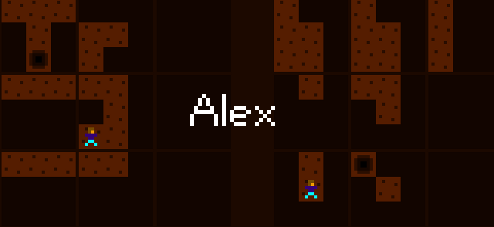![]() Holger Borum calls puzzle game Alex a "a four dimensional system represented in two dimensions". Reading that admittedly caused me to make my confused Scooby-Doo noise, but it turns out in practice, it's actually not all that mysterious. Maybe a little tricky, but not as bizarre as it sounds. As our blocky hero descends deeper into a series of caves he discovers beneath an idyllic meadow, because everyone knows the first thing you do when you find mysterious holes is throw yourself into them, you use [WASD] to move him around each area... and the [arrow] keys to make him transfer over into the next portion of the grid, aiming for the hole to get to the next level. With me so far? Well, when you start having to deal with, essentially, two versions of the same stage at once with two versions of Alex that move at the same time. Both need to have a clear path to move, and the one on the left uses an opposite control scheme... meaning, [WASD] will transfer him to a new grid square while [arrows] are what moves him around the one he's in. The [spacebar] will cause the two heroes to swap positions.
Holger Borum calls puzzle game Alex a "a four dimensional system represented in two dimensions". Reading that admittedly caused me to make my confused Scooby-Doo noise, but it turns out in practice, it's actually not all that mysterious. Maybe a little tricky, but not as bizarre as it sounds. As our blocky hero descends deeper into a series of caves he discovers beneath an idyllic meadow, because everyone knows the first thing you do when you find mysterious holes is throw yourself into them, you use [WASD] to move him around each area... and the [arrow] keys to make him transfer over into the next portion of the grid, aiming for the hole to get to the next level. With me so far? Well, when you start having to deal with, essentially, two versions of the same stage at once with two versions of Alex that move at the same time. Both need to have a clear path to move, and the one on the left uses an opposite control scheme... meaning, [WASD] will transfer him to a new grid square while [arrows] are what moves him around the one he's in. The [spacebar] will cause the two heroes to swap positions.
Confused yet? Well, don't be. As weird as it is to describe, Alex is one of those games where a few seconds of fiddling around will bring clarity even if the game itself actually explains very little. It feels very experimental, with its clever concept and lack of bells and whistles... which isn't necessarily a bad thing, though I could have done with a mute button given how short and annoying the level soundtrack loops are after a while. The level construction is actually a nice blend of simplistic and challenging, but for some players the way it simply sits back and folds its arms, forcing you to figure out the rules and restrictions of movement, is going to be more frustrating than a fun exercise in discovery. Still, it's a good idea even if it feels a little rough around the edges, and if you're looking for the sort of puzzle game that only seems easy and doesn't dress itself up, Alex is well worth checking out.






Not played tested either very well or at all in my opinion, that control system really does NOT work.
I dunno, I can't really think of a better way to control the system the game runs on, can you? It works fine for me, I just wish I could comprehend exactly what effect pushing space has.
Space switches the positions of the two characters. (But staying on the same side still.)
Due to how the levels are related it means you go from for example the left tile of the bottom section to the bottom tile of the left section.
All the tiles in section A on one side are all of tile A in every section on the other side.
I can't get past "crossroad". Does anyone have a solution for this?
I'm also struggling to get past Crossroads. Beginning to wonder now whether it's actually possible to beat it.
Experimenting with the controls, and using one of the level name "One World, Two views", I concluded that the geometry of the game is actually 4th dimensional
It can be modelled as a tesseract with passgesways suc that (x,y,z,w) and (z,w,x,y) positions are connected (the "Space" jump function)
I am also stuck in Crossroads
By experimenting with my moves, I found that you must start with this state
It remains to be proved that all paths will lead to a unwinnable situation to show that Crossroads is broken
http://i44.tinypic.com/11bj3vk.png
I've found a way through Crossroads.
Starting from the position in Halogen3.14's spoiler, these are the steps to finish the level:
W, Up, A, D, Down, Right, Up, Right, A, Left, A, then Up into the exit.
Update